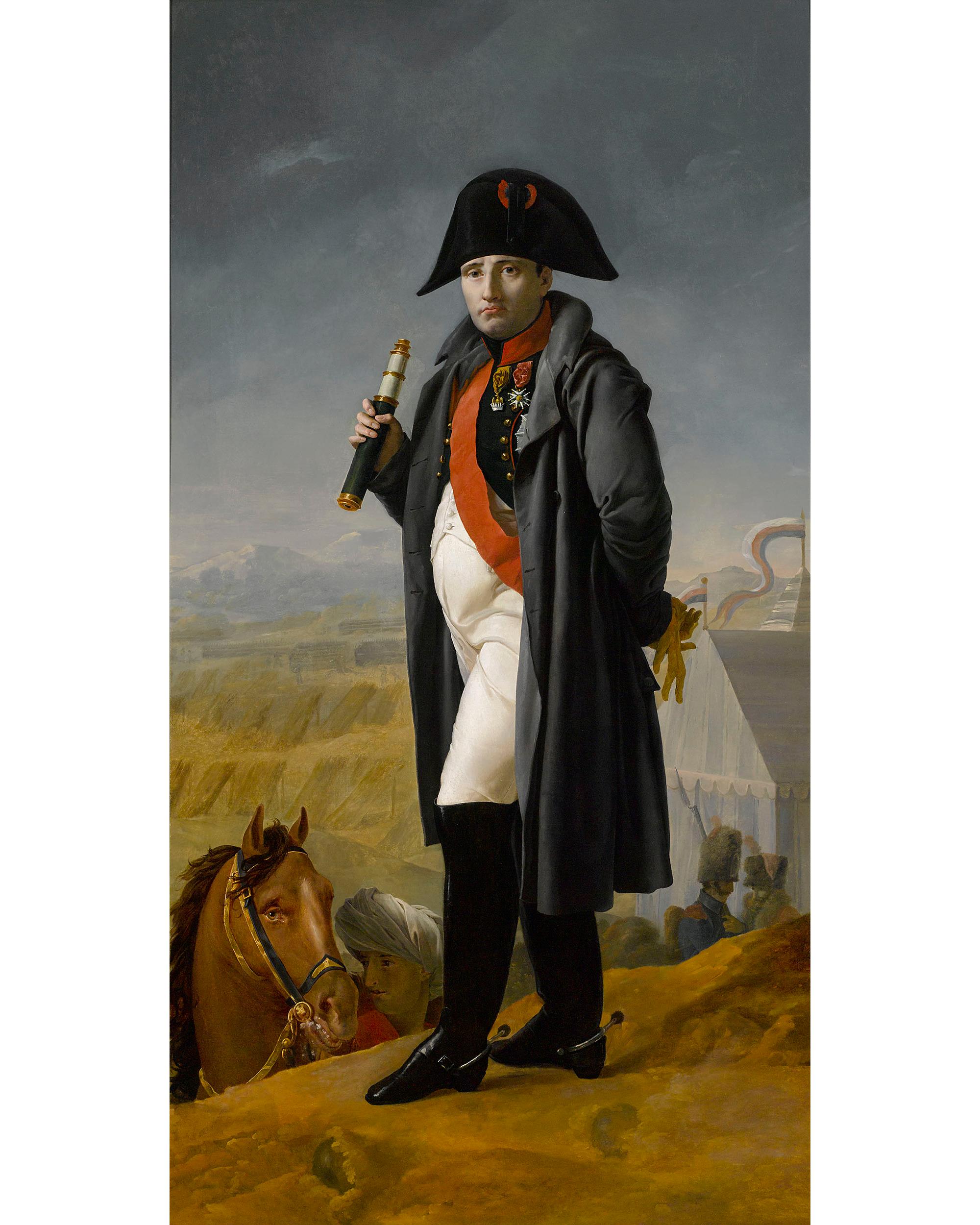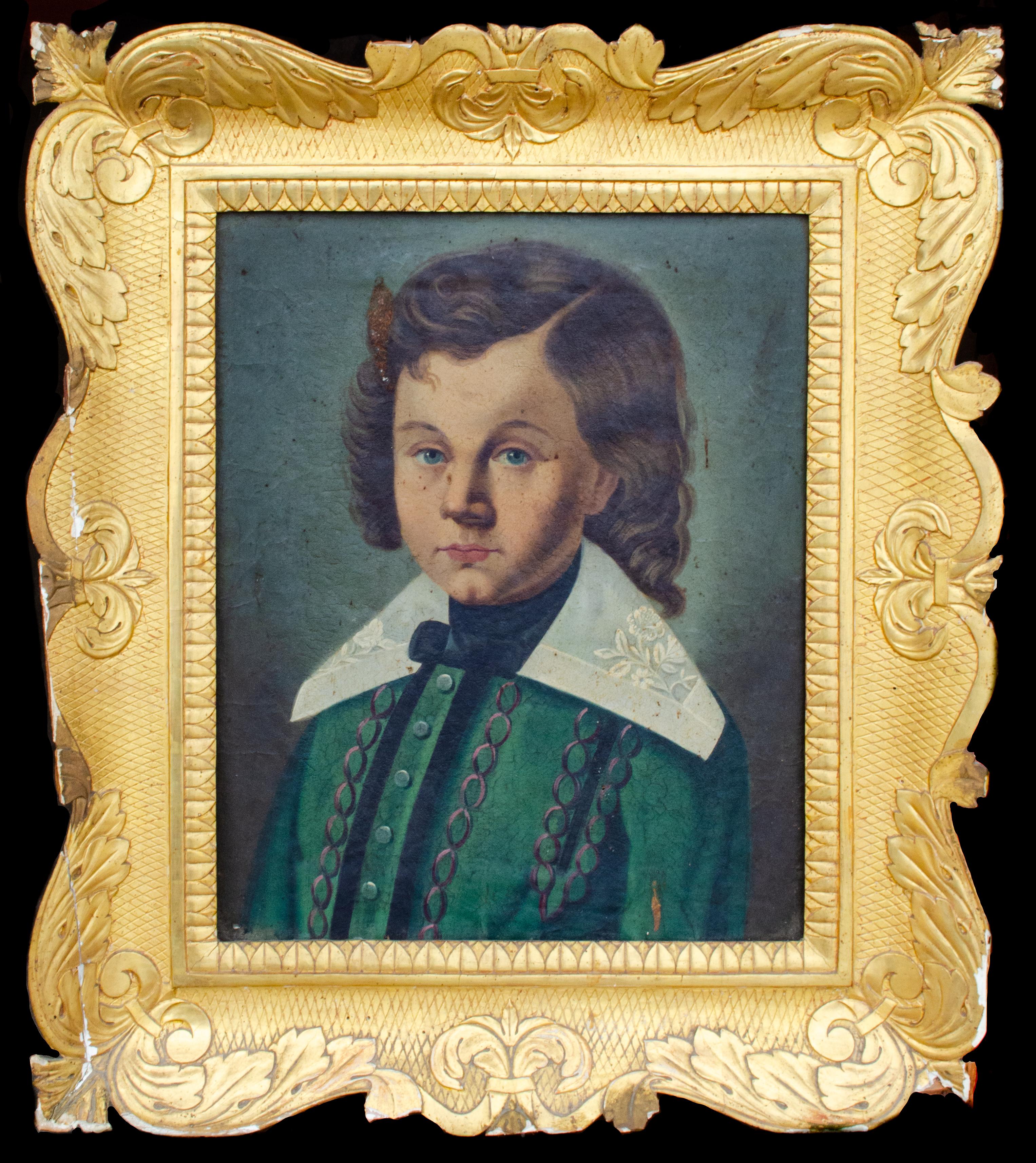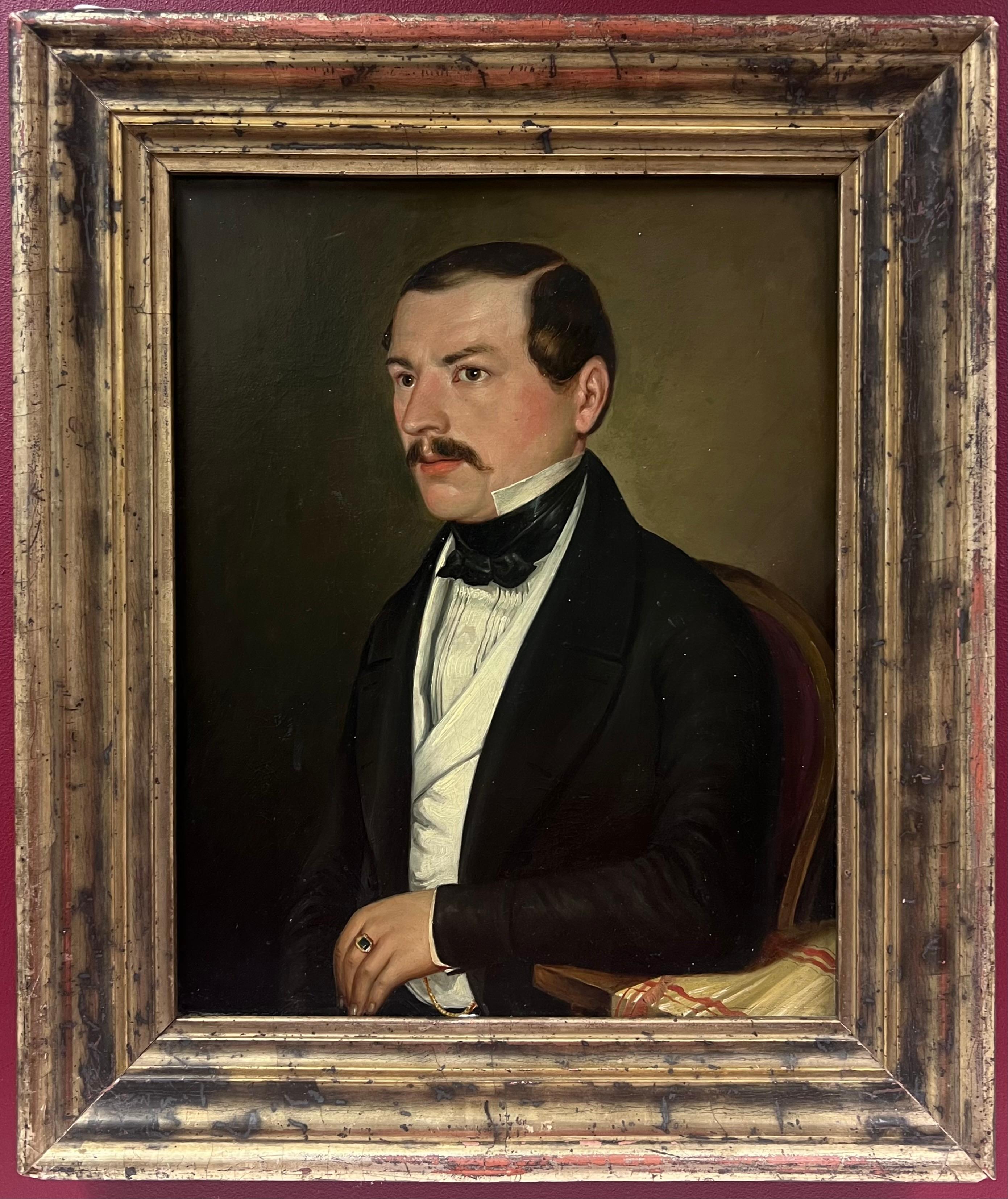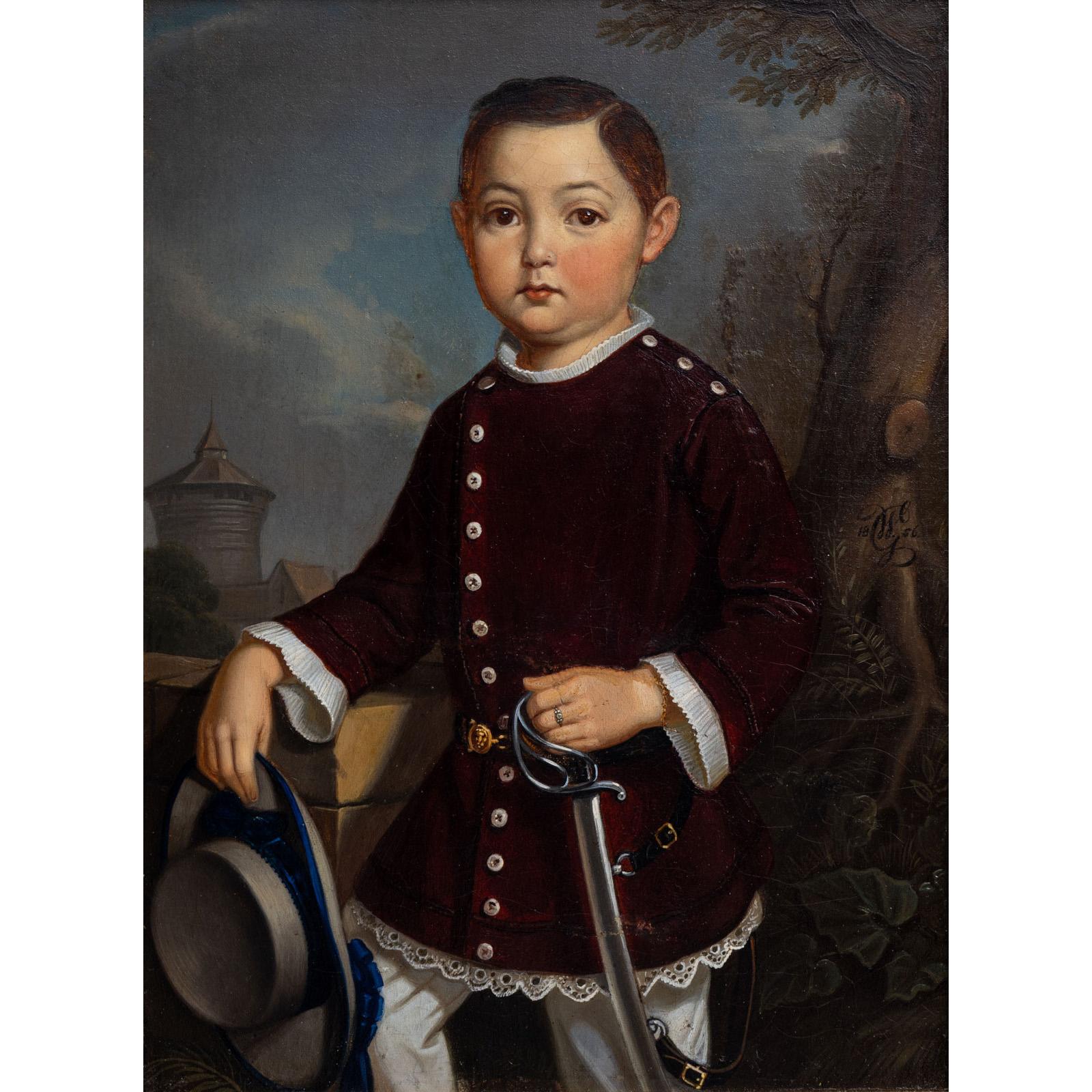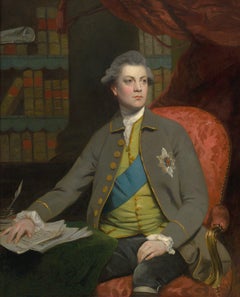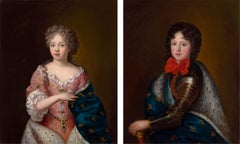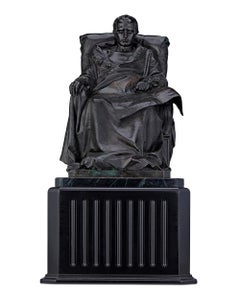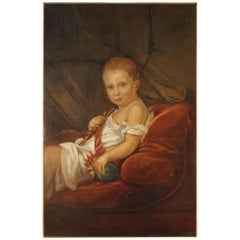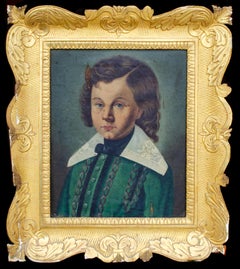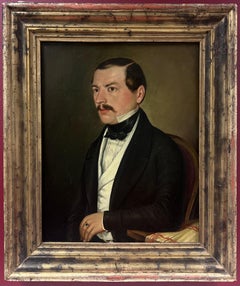Items Similar to Portrait of Napoléon II
Want more images or videos?
Request additional images or videos from the seller
1 of 5
Attributed to Johann Peter KrafftPortrait of Napoléon II1818
1818
$128,500
£99,655.40
€113,372.01
CA$183,865.65
A$200,888.50
CHF 105,655.66
MX$2,415,185.73
NOK 1,330,290.77
SEK 1,248,967.08
DKK 846,569.60
About the Item
The son of the legendary Napoléon Bonaparte, Napoléon François Charles Joseph, takes a spirited stance in this remarkable oil painting attributed to the Austrian portraitist Johann Peter Krafft. Believed to have been exhibited at the Exposition Universelle of 1900 in Paris, this work stands as a testament to both Austrian artistry and the legacy of one of the most powerful men in history.
After Napoléon's exile to the island of Elba in 1814, his son was seen by many of his supporters as the last hope of France. The child was named the ruler of half of Europe, holding the titles of Napoléon II, King of Rome, Prince of Parma, and the Duke of Reichstadt, the last given to him by his grandfather, Austria’s Emperor Francis II.
Following his father’s capture, the then four-year-old Napoléon and his mother fled to her homeland of Austria, never to see the fallen Emperor of France again. Once under the protection of the Habsburg Court, there was a concerted effort to sever all ties to his father. His mother left him in Vienna to pursue her own personal interests. In her absence, his grandfather assumed guardianship and gave him the title of the Duke of Reichstadt, dismissed all of his French attendants, and even disallowed the child to be referred to as “Napoléon”, instead insisting on the name “Franz” or “Francis”.
This portrait, which dates roughly to 1818, features the young Napoléon II as he gazes directly at the viewer and assumes a pose of nonchalant authority. He wears the dress of a Spanish Grandee, a style of costuming that enjoyed a resurgence in popularity in the late years of the prior century with the advent of the majismo tradition. The incorporation of it here, however, has been tied to the young Napoléon II’s acquisition of a new title in 1818 - the Duke of Reichstadt. It was this new title that was purportedly celebrated with a large costume ball, and it is for this reason, as interpreted by experts, that Napoléon II wears such distinctive garb in this portrait.
A closer look at the technique and style of this painting leads one to draw connections to the work of Johann Peter Krafft, who devoted much of his career to history and portrait painting. Born in Hanau, Germany, Krafft eventually moved to Vienna near the end of the eighteenth century and subsequently enrolled at the Academy of Fine Arts, Austria’s preeminent artistic academy. First studying alongside Heinrich Friedrich Füger, a history painter, Krafft was also afforded training under the masterful eye of Neoclassical painter Jacques-Louis David in Paris the early 1800s.
Shortly after this time abroad, Krafft returned to Vienna to establish his studio and gained fast acclaim for his striking portraits. His work garnered him membership in the Academy of Fine Arts as well as a professorial appointment there in 1823; in 1828, he was appointed the director of the Österreichische Galerie Belvedere, which still today is considered one of Austria’s most impressive artistic collections. Throughout these accomplishments, Krafft continued to accept increasingly prestigious commissions, including those from Emperor Franz I and his court.
Painted in 1818
Canvas: 55 1/4" high x 36 3/8" wide
Frame: 63 1/2" high x 44 1/4" wide
Provenance:
Haro, La Maison au Genie des Arts, 30 Rue du Colombier, Paris (label stamped on the reverse of the original canvas, the firm was at this address from 1826 - 1836);
Sibylle-Gabrielle Marie-Antoinette de Riquetti de Mirabeau, Comtesse de Martel de Janville, from 1849 until 1932, (French author who wrote under the pseudonym Gyp);
Thereafter, by descent in the family;
Private Collection, Michigan, until 2018
Exhibited:
Exposition Universelle de 1900, Paris, April 15 - November 12, 1900 (according to tradition in the Comtesse de Martel de Janville's family)
- Creator:Attributed to Johann Peter Krafft (1780 - 1856)
- Creation Year:1818
- Dimensions:Height: 63.5 in (161.29 cm)Width: 44.25 in (112.4 cm)
- Medium:
- Movement & Style:
- Period:
- Condition:
- Gallery Location:New Orleans, LA
- Reference Number:Seller: 30-93351stDibs: LU1865117951
About the Seller
5.0
Vetted Professional Seller
Every seller passes strict standards for authenticity and reliability
Established in 1912
1stDibs seller since 2013
19 sales on 1stDibs
Typical response time: 4 hours
- ShippingRetrieving quote...Shipping from: New Orleans, LA
- Return Policy
Authenticity Guarantee
In the unlikely event there’s an issue with an item’s authenticity, contact us within 1 year for a full refund. DetailsMoney-Back Guarantee
If your item is not as described, is damaged in transit, or does not arrive, contact us within 7 days for a full refund. Details24-Hour Cancellation
You have a 24-hour grace period in which to reconsider your purchase, with no questions asked.Vetted Professional Sellers
Our world-class sellers must adhere to strict standards for service and quality, maintaining the integrity of our listings.Price-Match Guarantee
If you find that a seller listed the same item for a lower price elsewhere, we’ll match it.Trusted Global Delivery
Our best-in-class carrier network provides specialized shipping options worldwide, including custom delivery.More From This Seller
View AllNapoléon before the Battle of Moscow
Located in New Orleans, LA
Emperor Napoléon I was and remains one of the most legendary military and political figures in history, having held, for a brief period, the fate of the Western world in his hands. Composed by the French painter Joseph Franque...
Category
Early 19th Century Academic Portrait Paintings
Materials
Canvas, Oil
Henry Bowles Howard, 12th Earl Of Suffolk And 5th Earl Of Berkshire
Located in New Orleans, LA
Sir Joshua Reynolds
1723-1792 British
Sir Henry Bowles Howard, 12th Earl of Suffolk and 5th Earl of Berkshire
Oil on canvas
Sir Joshua Reynolds is unequivocally considered the most important English portraitist of the 18th century who was instrumental in adapting the Grand Manner style in the portrait genre. In fact, when the Royal Academy was founded in 1768, Reynolds was elected its first President, setting the precedent of quality for which all other portraitists would strive.
Reynolds's portrait of Henry Bowles Howard, 12th Earl of Suffolk, showcases his genius in the genre and mastery over the medium. Reynolds’s portrait of the Earl expertly invokes classical values with strong lighting, rich colors and expert attention to detail to help underscore the prominence and revered echelon of the sitter. Howard was an esteemed British politician and Knight of the Garter. He served as Secretary of State for the Northern Department from 1771 to 1779, and he played a key role in utilizing mercenaries during the American Revolution and safeguarding Sweden's independence.
The portrait employs Reynolds's signature style to render Howard rightfully as a gentleman of distinction. Captured seated in a stately library, the Earl appears learned and austere as he places one hand upon a stack of important documents and looks wistfully into the distance. Reynolds makes these compositional choices decisively, as the seated position gives Howard a weighty appearance of importance and the semi-profile turn captures his countenance at an attractive angle that highlights his strong, masculine features. The work draws on the classical conventions of Greek and Roman art and the Italian Renaissance masters, anchoring the nobleman in a history of refinement. Everything from his strong yet welcoming expression to his pale face enlivened by a rush of blood to the cheeks presents the picture of a strong, vital and powerful leader.
As the first president of the Royal Academy in London, Reynolds’s commissions raised the status of an artist in Britain during the Romantic period and also established the portrait as an esteemed high art genre that garnered equal import to the history paintings that reigned supreme in decades prior. Today, Reynolds’s works grace the walls of the most important museums in the world, including the Louvre, the Metropolitan Museum of Art, and the National Gallery in London, among others.
Circa 1770
Canvas: 50 1/2" high x 40 1/4" wide
Framed: 61" high x 52 1/2" wide x 3 1/2" deep
Provenance:
Sir Henry Howard, 12th Earl of Suffolk and 5th Earl of Berkshire, 1739-1779
His mother, Lady Mary Howard, née Finch, Lady Andover, d. 1803
Acquired by descent to her daughter, Frances, and her husband Richard Bagot (later Howard)
Acquired by descent to their daughter, Mary (1784-1877), and her husband Col. Fulke Greville Upton (later Howard), d. 1846
Acquired by descent to Lieutenant Colonel H.R.G. Howard
Sale, Christie's, London, March 24, 1961, no. 29
Julius Weitzner, London and New York
Sale, Paris, Musée Galliéra, December 7, 1965, no. 165
Newhouse Galleries, New York, NY
Mr. and Mrs. F. Howard Walsh, Fort Worth, Texas, 1966
Walsh Family Art Trust
Private collection, Oregon
M.S. Rau, New Orleans
Exhibited:
British Institution, London, 1844, no. 130, loaned by the Hon. Fulke Greville Howard.
South Kensington, "Second special exhibition of National Portraits," 1867, no. 478, lent by the Hon. Mrs. Greville.
Agnew's, London, 1903, no. 17.
Literature:
Algernon Graves and W. V. Cronin, A History of the Works of Sir Joshua Reynolds, P.R.A., vol. 3 (London, 1899), p. 945.
David Mannings...
Category
18th Century Other Art Style Portrait Paintings
Materials
Canvas, Oil
Pair of Royal Portraits of the Duke and Duchess of Burgundy
By Pierre Gobert
Located in New Orleans, LA
Follower of Pierre Gobert
18th century French
The Duke and Duchess of Burgundy
Oil on canvas
Refinement and intricacy characterize these royal portra...
Category
18th Century Portrait Paintings
Materials
Canvas, Oil
THE LAST DAYS OF NAPOLÉON BY
Located in New Orleans, LA
This highly evocative bronze by Vincenzo Vela captures the deposed Emperor Napoléon on his deathbed, holding a map of Europe and lost in thought about what might have been. Remarkable among most portrayals of the exiled leader, this highly detailed sculpture depicts Napoléon at his most vulnerable. Nonetheless, Vela perfectly captures his still-heroic bearing, which imparts to this work a monumental quality and quiet dignity. The mate to this figure is the colossal marble at the Musée du Château de Malmaison, which was shown at the Paris Salon of 1867.
The founder of the verismo movement in Italy, Vela was one of the great exponents of realism in sculpture. Born in Ligornetto, Switzerland in 1820, he studied under celebrated sculptor, Benedetto Cacciatori. He was also influenced both by the work of Tuscan sculptor Lorenzo Bartolini, who seamlessly combined neoclassicism with naturalism and the romantic painting of Francesco Hayez...
Category
19th Century Realist Figurative Sculptures
Materials
Marble, Bronze
Portrait Of A Gentleman By Frans Hals
Located in New Orleans, LA
Frans Hals
1582-1666 Dutch
Portrait of a Gentleman
(possibly Theodore Blevet)
Oil on panel
“Frans Hals is a colourist among the colourists...Frans Hals must have had twenty-seven blacks...
Category
17th Century Old Masters Portrait Paintings
Materials
Oil, Panel
Price Upon Request
The Connoisseur By Georges Croegaert
By Georges Croegaert
Located in New Orleans, LA
Georges Croegaert
1848-1923 Belgian
The Connoisseur
Signed "Georges Croegaert Paris" (lower right)
Oil on panel
A Cardinal peers through a magnifying glass at gilded treasures in...
Category
19th Century Academic Figurative Paintings
Materials
Oil, Panel
You May Also Like
Portrait of Colonel Charles-Louis-Prosper Marquis de Chérisey (1786-1837)
Located in Paris, IDF
After Louis-Stanislas MARIN-LAVIGNE (Paris, 1797 – Paris, 1860)
Portrait of Colonel Charles-Louis-Prosper Marquis de Chérisey (1786-1837)
in the uniform of commander of the 38th lin...
Category
Mid-19th Century French School Portrait Paintings
Materials
Oil
19th Century French Oil on Canvas Painting of the Young Napoleon De Bonaparte
Located in Round Top, TX
A large-scale 19th century French unframed oil on canvas painting of the young Napoleon De Bonaparte. Some restoration.
Category
Antique 19th Century French Paintings
Portrait of a Young Prince, 19th c., by Mystery Artist
Located in New York, NY
Mystery Artist
Untitled (Young Prince), c. 1800-1900
Oil on canvas
16 x 13 in.
Framed: 23 x 19 1/2 x 2 in.
Category
19th Century Old Masters Portrait Paintings
Materials
Canvas, Oil
19th-Century French Oil Portrait of Smart Gentleman in Formal Attire
Located in Cirencester, Gloucestershire
Portrait of a Gentleman in Formal Attire
French School, 19th century
oil on board, framed
framed: 17 x 14 inches
board : 13 x 10.5 inches
Provenance: private collection, Paris, Franc...
Category
19th Century French School Portrait Paintings
Materials
Oil
$1,315 Sale Price
30% Off
Georg Wilhelm Wanderer (1804-1863), Portrait of a boy, Nuremberg 1836
Located in Greding, DE
Portrait of a boy with sword and hat in the wine-red costume of the Nuremberg Citizens' Guard. In the background is a view of Nuremberg with one of the city towers, monogrammed GW an...
Category
19th Century Figurative Paintings
Materials
Canvas, Oil
Fine 1800's Portrait of Young Aristocratic Boy with Letter & Pen Oil on Canvas
Located in Cirencester, Gloucestershire
Portrait of a Young Aristocrat
French School, circa 1800's
circle of Louis Leopold Boilly (1761-1845)
oil painting on canvas, framed
canvas: 16 x 13.5 inches
frame: 21 x 18 inches
p...
Category
Early 19th Century Rococo Portrait Paintings
Materials
Canvas, Oil
$3,758 Sale Price
30% Off
More Ways To Browse
Antique Advent
Napoleon Oil Painting
Portrait Of Napoleon
Spanish Costume
Oil Portrait Napoleon
Scipione Pulzone
Trump Portrait
Victor Passmore
Viktoria Canvas
William Wilberforce
Winston Churchill Portrait
Yuval Mahler On Sale
16th Century Frame German
17th C Dutch Portraits
18th Century Military Portrait
18th Century Portrait Of Lady By A Sweden
18th Century Scottish Portrait
Alois Priechenfried

